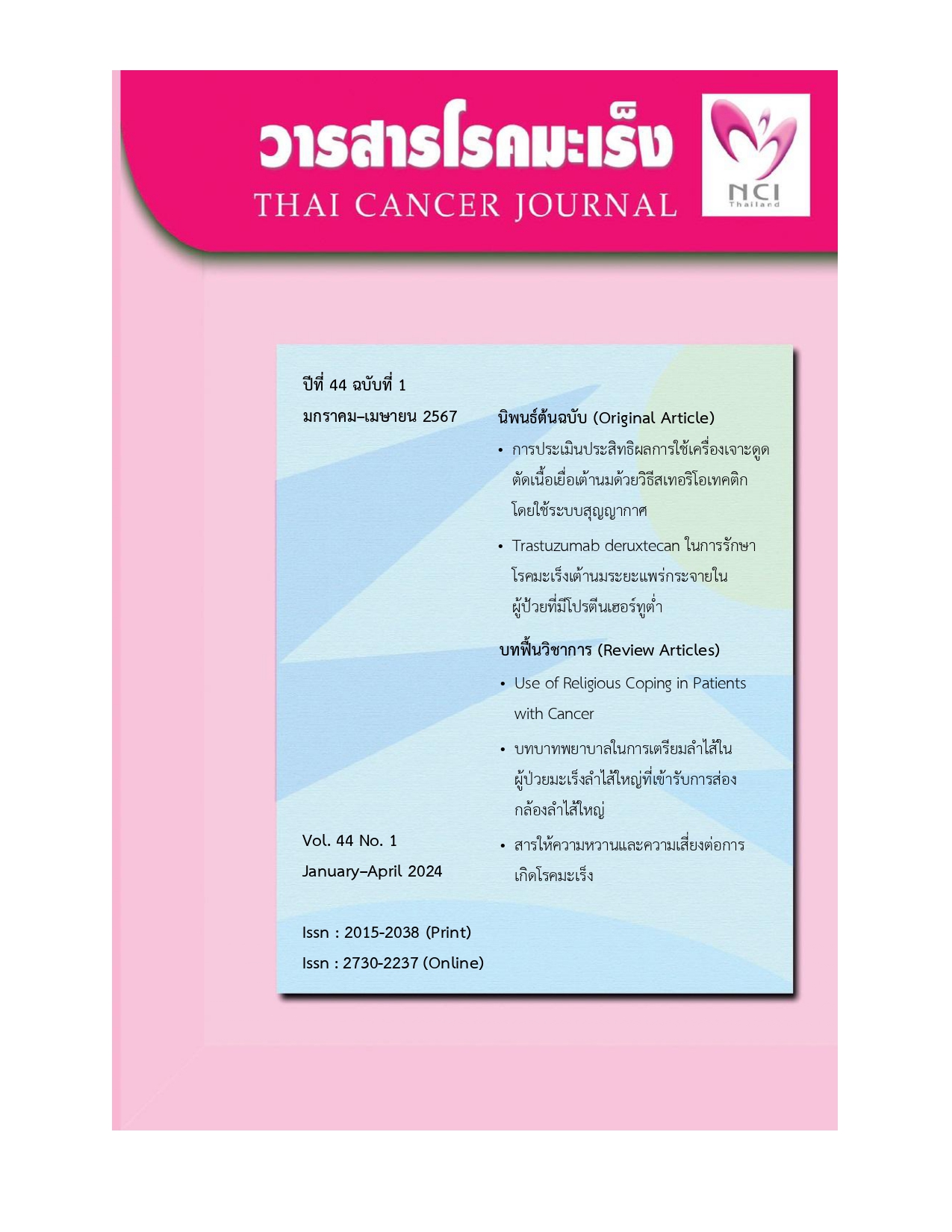Aspartame and the risk of cancer
Keywords:
aspartame, sweetener, low-calorie or no-calorie sugar substitute sweeteners, exposureAbstract
Aspartame is a non-calorie or low-calorie sweetener that is 150–200 times sweeter than sucrose. It can be decomposed aspartic acid, phenylalanine, and methanol are commonly used as sweeteners in non-alcoholic beverages such as tea, ready-to-drink coffee, and cocoa mix is often used in the diet of people with health problems such as diabetes, obesity, or dietary weight control. It controls energy intake and does not affect blood sugar levels. But it should not be used in amounts exceeding the amount of substances that can be consumed without causing harm, as determined by The World Health Organization (WHO) and the Food and Agriculture Organization (FAO) Joint Expert Committee on Food Additives (JECFA) and the requirements of the Ministry of Public Health Announcement No. 389 B.E. 2018 regarding food additives (No. 5). In 2023, the World Health Organization (WHO) will classify aspartame as a substance that may cause humans cancer group 2B (IARC group 2B) based on information aspartame and risk of carcinogenicity, consumption has been found to increase weight and fat mass. Sweetener intake was associated with the risk of developing many types of cancer, such as leukemia lymphatic cancer, breast cancer, prostate cancer, and obesity-related cancers in human. The results of this study found that aspartame increased the incidence of leukemia and lymphoma in rodents. It also changes the mRNA levels of cancer-causing genes, resulting in a higher risk of breast and prostate cancer. However, this information is a preliminary study. More studies should be conducted until clear information is obtained, including further studies on the population. (Thai Cancer J 2024;44:21-30)
References
สำนักข่าวสร้างสุข สำนักงานกองทุนสนับสนุนการสร้างเสริมสุขภาพ. รณรงค์ลดหวาน ลดโรค สั่งหวานน้อยไม่เกิน 2 ช้อนชา ปรับพฤติกรรมใหม่ ลดเสี่ยงป่วยโรค NCDs [อินเทอร์เน็ต]. [เข้าถึงเมื่อ 25 มี.ค.2567]. เข้าถึงได้จาก: https://www.thaihealth.or.th/?p=314094.
The Nation. The Public Health Ministry is targeting sweet drinks in its latest campaign to curb Thais’ health-damaging addiction to sugar [Internet]. [cited 2023 Dec 7]. Available from:https://www.nationthailand.com/lifestyle/30403903.
World Health Organization. WHO calls on countries to reduce sugars intake among adults and children [Internet]. [cited 2023 Dec 7]. Available from: https://www.who.int/news-room/detail/04-03-2015-who-calls-on-countries-to-reduce-sugars-intake-among-adults-and children
ปิยะพันธ์ พฤกษพานิช. เครื่องดื่มหวาน ๆ อร่อยแต่อันตราย เป็นภัยต่อสุขภาพ [อินเทอร์เน็ต]. [เข้าถึงเมื่อ 7 ธ.ค. 2566]. เข้าถึงได้จาก: https://chulalongkornhospital.go.th/kcmh/line.
กองสุขศึกษา กรมสนับสนุนบริการสุขภาพ กระทรวงสาธารณสุข. กินน้ำตาลมากเกินไป...เป็นภัยต่อสุขภาพ [อินเทอร์เน็ต]. [เข้าถึงเมื่อ 7 ธ.ค. 2566]. เข้าถึงได้จาก: https://www.prd.go.th/th/content/ category/detail/id/31/iid/206377.
Schorb S, Gleiss K, Wedekind R, Suonio E, Kull AK, Khuntz M, et al. Assessment of aspartame (E951) occurrence in selected foods and beverages on the German Market 2000-2022. Foods 2023;12:21-56.
World Health Organization (WHO). Aspartame hazard and risk assessment results released [Internet]. [cited 2024 Mar 21]. Available from: https://www.who.int/news/item/14-07-2023-aspartame-hazard-and-risk-assessment-results-released.
Harvard TH. Chan school of Public Health. Low-calorie sweeteners [Internet]. [cited 2024 Mar 21]. Available from:https://www.hsph.harvard.edu/nutritionsource/healthy-drinks artificial-sweeteners/.
FDA: U.S. Food and Drug Administration. High-Intensity Sweeteners [Internet]. [cited 2024 Mar 21]. Available from: https://www.fda.gov/food/food-additives-petitions/high-intensity-sweeteners.
สำนักโภชนาการ กรมอนามัย. สารให้ความหวานทดแทนน้ำตาล [อินเทอร์เน็ต]. [เข้าถึงเมื่อ 7 ธ.ค.2566]. เข้าถึงได้จาก: https://nutrition2.anamai.moph.go.th/webupload/6x22caac0452648c8dd1f 534819ba2f16c/m_document/31949/14470/file_download/0f0233d34bfff924f62bca83e4de0c03.pdf
Calorie control council. Low calorie sweetener: aspartame [Internet]. [cited 2023 Aug 21]. Available from: https://www.caloriecontrol.org/ aspartame. html.
European Commission-Scientific committee on food. Scientific facts on aspartame [Internet]. [cited 2023 Aug 21]. Available from: http://www.greenfacts.org/en/aspartame/l-3/aspartame-1.html.
วรรณคล เชื้อมงคล. สารให้ความหวาน: การใช้และความปลอดภัย. วารสารวิทยาศาสตร์สุขภาพแห่งประเทศไทย. 2551;3:161-8.
Maler V, Goetz V, Tardieu M, Khalil AE, Alili JM, Meunier P, et al. Aspartame and phenylketonuria: An analysis of the daily phenylalanine intake of aspartame containing drugs marketed in France. Orphanet J Rare Dis 2023:18;14
พิมพ์เพ็ญ พรเฉลิมพงศ์, นิธิยา รัตนาปนนท์. Aspartame/แอสพาร์แทม. Food Network Solution ศูนย์เครือข่ายข้อมูลอาหาร [อินเทอร์เน็ต]. [เข้าถึงเมื่อ 7 ธ.ค. 2566]. Available from: https://www.foodnetworksolution.com/wiki/word/1209/aspartame
National Institute of Standards and Technology (NIST) Aspartame [Internet]. [cited 2023 Mar 21]. Available from: https://webbook.nist.gov/cgi/inchi/InChI%3D1S/C14H18N2O5/c1-21-14%2820%2911%287-9-5-3-2-4-69%291613%2819%2910%2815%29812%2817%2918/h26%2C1011H%2C78%2C15H2%2C1H3%2C%28H%2C16%2C19%29%28H%2C17%2C18%29.
Magnuson BA, Burdock GA, Doull J, Kroes RM, Marsh GM, Pariza MW, et al. A safety evaluation based on current use levels, regulations, and toxicological and epidemiological studies. Crit Rev toxicol 2007;37:629-727.
Oppermann JA, Muldoon E, Ranney RE. Metabolism of aspartame in monkeys. J Nutr 1973;103:1454-9.
Ranney RE, Oppermann JA. A review of the metabolism of the aspartyl moiety of aspartame in experimental animals and man. J Environ Pathol Toxicol 1979;2:979-85.
Reid AE, Chauhan BF, Rabbani R, Lys J, Copstein L, Mann A, et al. Early exposure to nonnutritive sweeteners and long-term metabolic health: A systematic review. Pediatrics 2016;137:e20153603. doi: 10.1542/peds.2015-3603.
Archibald AJ, Dolinsky VW, Azad MB. Early-life exposure to non-nutritive sweeteners and the developmental origins of childhood obesity: Global evidence from human and rodent studies. Nutrients 2018;10:194. doi: 10.3390/nu10020194.
Chen YC, Yeh YC, Lin YF, Au HK, Hsia SM, Chen YH, et al. Aspartame consumption, mitochondrial disorder-induced impaired ovarian function, and infertility risk. Int J Mol Sci 2022;23:12740. doi: 10.3390/ijms232112740.
ปรัญรัชต์ ธนวิยุทธ์ภัคดี, ชนิพรรณ บุตรยี่, วันเพ็ญ วิมลพีรพัฒนา, พัชรี มั่นคง, ทรงศักดิ์ ศรีอนุชา. การประเมินความเสี่ยงของการได้รับสัมผัสเอสพาร์เทม อะซีซัลเฟม-เค และซูคราโลส จากอาหารและเครื่องดื่มในประชากรไทย. วารสารพิษวิทยาไทย 2564;36:113-30.
International Agency of Research on Cancer (IARC). Aspartame hazard and risk assessment results released [Internet]. [cited 2023 Aug 22]. Available from: https://www.iarc.who.int/ news-events/aspartame-hazard-and-risk-assessment-results-released/.
World Health Organization (WHO). Aspartame hazard and risk assessment results released [Internet]. [cited 2023 Aug 22]. Available from: https://www.who.int/news/item/14-07-2023-aspartame-hazard-and-risk-assessment-results-released.
Landrigan PJ, Straif K. Aspartame and cancer-new evidence for causation. Environ health 2021;20-42.
Soffritti M, Belpoggi F, Tibaldi E, Degli Esposti D, Lauriola M. Life-span exposure to low doses of aspartame beginning during prenatal life increases cancer effects in rats. Environ health perspect. 2007;115:1293-7.
Finamor IA, Bressan CA, Torres-Cuevas I, Rius-Pérez S, Veiga Md, Rocha MI, Pavanato MA, et al. Long-term aspartame administration leads to fibrosis, inflammasome activation, and gluconeogenesis impairment in the liver of mice. Biology (Basel) 2021;10:82.
Debras C, Chazelas E, Srour B, Druesne-Pecollo N, Esseddik Y, Edelenyi FSd. Artificial sweeteners and cancer risk: Results from the NutriNet-Sant population-based cohort study. PLoS Med 2022;19:e1003950. doi: 10.1371/journal.pmed.1003950.
เครือไทยโฮลดิ้งส์. 6 โรคที่คนไทยเสียชีวิตมากที่สุด [อินเทอร์เน็ต]. [เข้าถึงเมื่อ 7 ธ.ค. 2566]. เข้าถึงได้จาก: https://www.southeastlife.co.th/blog/detail/top-6-casualties-diseases-thailand.
Downloads
Published
Issue
Section
License

This work is licensed under a Creative Commons Attribution-NonCommercial-NoDerivatives 4.0 International License.
บทความทีตีพิมพ์ในวารสารโรคมะเร็งนี้ถือว่าเป็นลิขสิทธิ์ของมูลนิธิสถาบันมะเร็งแห่งชาติ และผลงานวิชาการหรือวิจัยของคณะผู้เขียน ไม่ใช่ความคิดเห็นของบรรณาธิการหรือผู้จัดทํา







